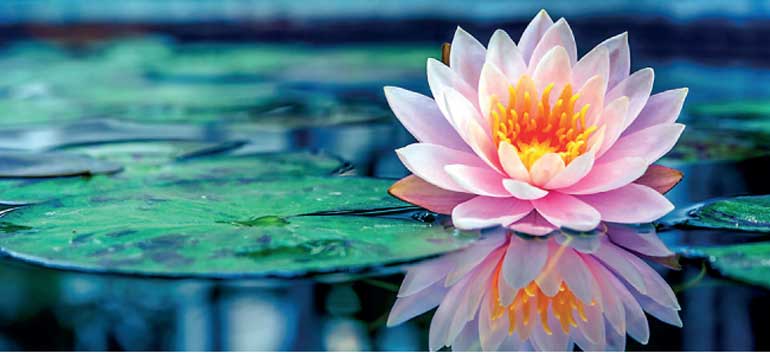Sunday Nov 16, 2025
Sunday Nov 16, 2025
Saturday, 17 August 2024 00:18 - - {{hitsCtrl.values.hits}}

The lotus reminds us that whatever challenges – abuse, brutal insults and fake news – that come in the way, we have the potential within us to overcome them and achieve a state of sustained action
By Don de Silva
In the teachings of the Buddha in the Tipițaka, the Three Baskets, the lotus flower is a powerful symbol of liberation and transformation. Just as a lotus rises from the mud and blooms untainted above the water, so too can individuals rise above their worldly challenges to attain transformation.
This metaphor is beautifully encapsulated in several of the Buddha’s discourses, illustrating the journey from doubt to liberation.
One of the most evocative uses of the lotus metaphor can be found in the section on Flowers in the Dhammapada, in verse 58, that describes the growth of a lotus from a rubbish heap by the roadside:
“Just as from a heap of rubbish, thrown by the side of a highway, a lotus might blossom, fragrant and delightful.”
Yathā saṅkāradhānasmiṁ ujjhitasmiṁ mahāpathe; Padumaṁ tattha jāyetha, sucigandhaṁ manoramaṁ.
This verse captures the essence of transformation and hope. It suggests that beauty and integrity can arise from the most unlikely toxic environments, reflecting the potential for spiritual awakening in all beings, regardless of their past actions or current conditions. Then in another discourse from the Anguttara Nikaya (10.81), the Buddha uses the lotus flower to explain the ability to break the fetters or chains that bind us to the cycle of a conditioned existence. These include: form, feeling, perception, mental formations, consciousness, rebirth, aging, death, suffering, and defilements.
Speaking to a monk, Venerable Bāhuna, describes his liberation:
“Suppose there was a blue, pink or white lotus. Though it sprouted and grew in the water, it would rise up above the water and stand with no water clinging to it.”
Seyyathāpi, vāhana, uppalaṁ vā padumaṁ vā puṇḍarīkaṁ vā udake jātaṁ udake saṁvaḍḍhaṁ udakā paccuggamma ṭhitaṁ anupalittaṁ udakena.
“In the same way, the Realised One has escaped from ten things, so that he lives detached, liberated, his mind free of limits.”
evamevaṁ kho, vāhana, imehi dasahi dhammehi tathāgato nissaṭo visaṁyutto vippamutto vimariyādīkatena cetasā viharatī”ti.
Here, the different colours of the lotus — blue, pink, and white —symbolise various aspects of the enlightened mind, not corrupted by the ‘water’ of worldly challenges. This metaphor not only highlights the Buddha’s own liberation but also serves as an inspiration for practitioners to follow the path to awareness.
According to the Digital Pāli Dictionary dpdict.net, another Pali name for the lotus flower is kamala, further enriching the cultural and symbolic significance of this beautiful bloom.
The Buddha delivered several discourse while being next to the Gaggarā Lotus Pond, near the ancient city of Campā, in the nation of Anga, in ancient northern India, serving as a backdrop.
The pond itself is a serene symbol of calm and integrity that the lotus represents. It is in such settings that the Buddha often delivered his discourses, using the natural environment to illustrate profound spiritual truths.
The relevance of the lotus as a symbol of liberation extends beyond its historical context. In today’s world, the teachings of the Buddha, illustrated through the metaphor of the lotus, offer wisdom and guidance. The lotus reminds us that whatever challenges – abuse, brutal insults and fake news – that come in the way, we have the potential within us to overcome them and achieve a state of sustained action.
The lotus flower, as described by the Buddha, is more than just a symbol; it is a powerful representation of the potential for growth, transformation, and liberation inherent in every individual. The Buddha’s teachings, illustrated through this beautiful metaphor, continue to inspire and guide us on our spiritual journey to go forward to the future.
Sources:
The ancient city of Campā, which was the capital of the Anga Mahajanapada, one of the 16 mahajanapadas (states), cited by the Buddha in some of his discourses. The city is identified with the modern-day city of Bhagalpur in the state of Bihar, India. The area near the modern-day Chandan (Chanan) River is believed to be where the ancient city of Campā was located.
(The writer is a former director of the United Nations Environment Programme (UNEP) who links traditional knowledge, environmental sciences and spiritual/cultural heritage. Don de Silva is Buddhist Counsellor and Mentor at several UK universities. He is also involved with Sri Lankan universities. He researches the Buddhism based Intangible Cultural Heritage and its relevance to sustainability, peace, unity, abundance and communication systems.)